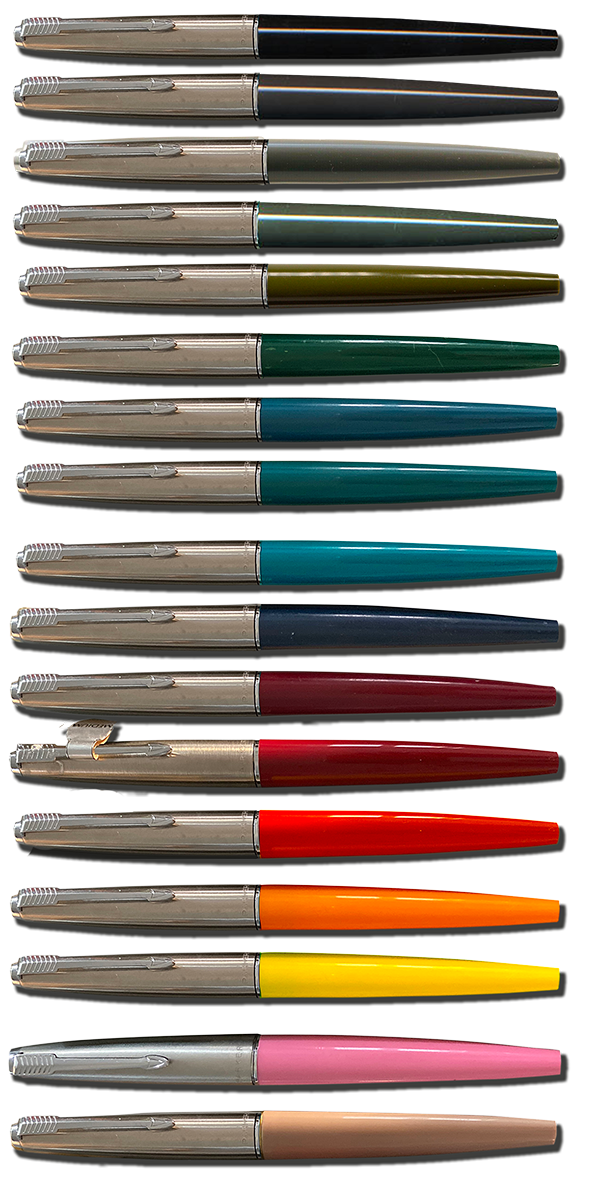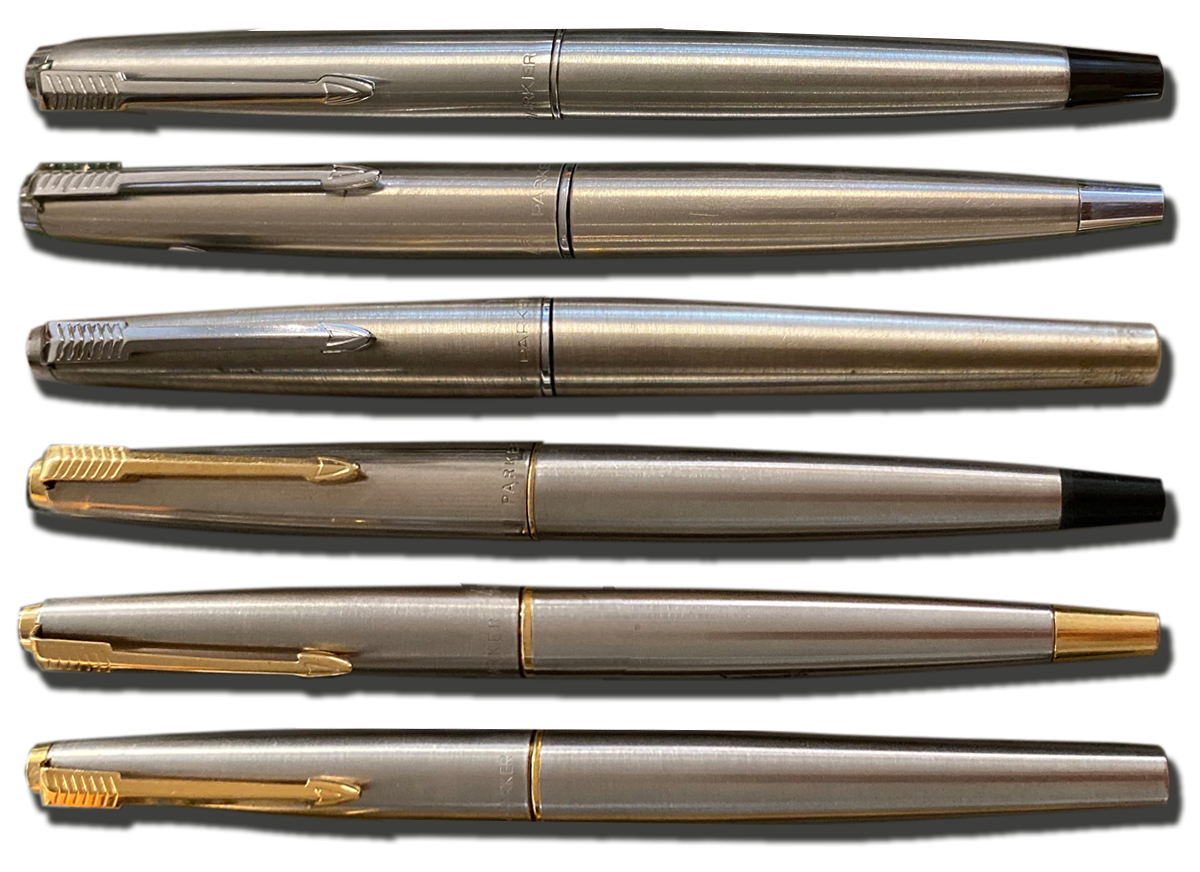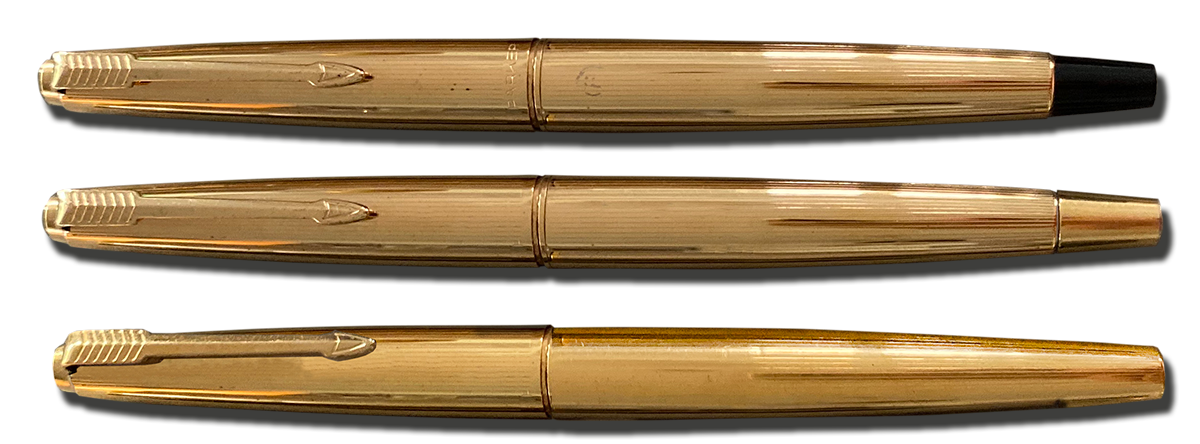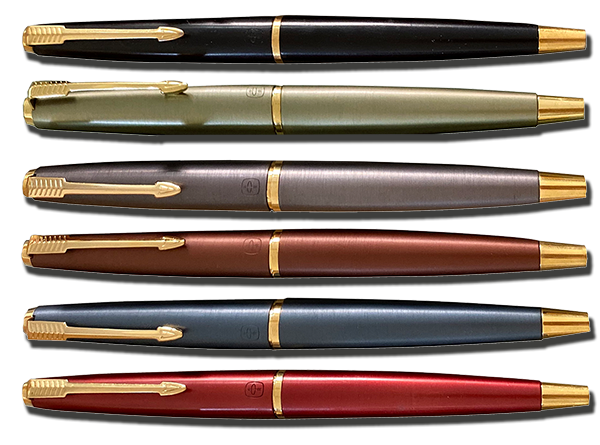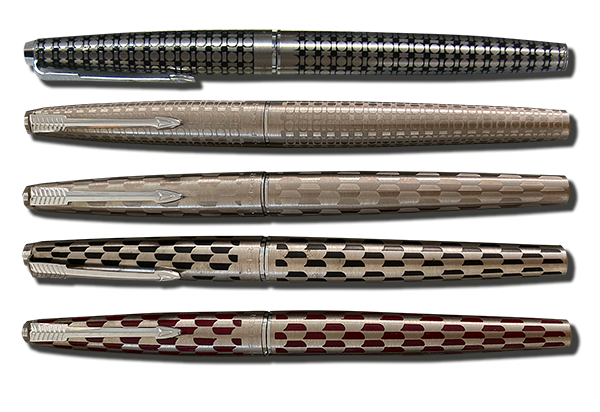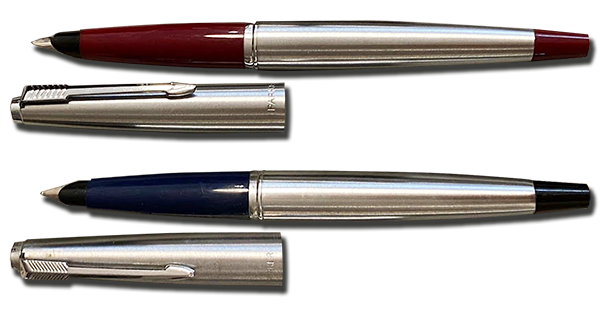Parkercollector.com — Online for 30 years! Click to read:
Parker "45"
1960-2007
HISTORY
The Parker "45" was initially a low-priced pen, eventually made in many colours and finishes — one of Parker’s great survivors. Parker always tried to fill the demands for both expensive and economy line pens. During the Duofold era there had been the Raven Black, the Writefine, the Pastel and the very attractive Thrift Time Pens: Duette, Premiere and the Moderne. During the Vacumatic era, Parker offered the very beautiful and popular Challenger and the Parkette. During the 1950s, following the phenomenal success of the Parker 51, Parker produced three lines aimed at the economy market — so-called school pens.
The main difference to the top lines was the material rather than the design. Thus, the economy pens are more prone to breakage and often sported alloy, rather than gold, nibs. The threesome was the Parker 51 Special, virtually identical to the Parker 51 save the gold nib; the Parker 21, which, adding a few colours, also closely followed the design of the Parker 51, with the exception of an assortment of clip designs and, again, the lack of the gold nib; and the Parker 41, very similar to the Parker 21 but offered in a range of clear "youthful" colours, today much sought after by collectors.
Image © Tsachi Mitsenmacher, Susan Wirth, et al.
The many colours of the Parker 45 Classic
Parker was, however, working on an entirely new concept of school pen. This pen, subsequently known as the Parker "45" (actually named after the western revolver), was aimed to shoot into and make a kill on the economy market. And you even loaded it with cartridges! It was introduced in 1960. The model was referred to as the Classic.
The Parker "45" was designed by Don Doman (who also designed the Jotter, Parker "61", Parker "VP", Parker "75", Parker "T1" and Liquid Lead). He based it on an Eversharp design, called the Eversharp "10.000", a cartridge pen — the rights to which Parker acquired when they bought the pen division of Eversharp in 1957 (read more in the Parker "19" chapter). Not wanting to differ too much from their prize-winning design of the milk cow Parker "51", Doman initially kept the metal cap and the arrow clip but adopted the stylised clip of the Parker 21 Super, introduced in 1956.
Image © courtesy of Tsachi Mitsenmacher
Parker 45 Classic and Arrow Demonstrator, ca 1966.
The Parker Classic colour range:

Black (#11)

Charcoal (Dark Gray) (#21)

Gray

Navy Gray

Olive Gray

(Forest) Green (#18)

Teal Blue (Blue/Green)

Vista Blue (Turquoise) (#35)

Light Blue (Aqua)

Dark Blue (Midnight) (#16)

Maroon (Burgundy) (#17)

Rage Red (#23)

Matador Red (#67)

Orange (#78)

Yellow

Pink

Tan
(The numbers are Parker’s own colour codes)
The body of the Parker "45" was tapered at both ends, creating a slimmer and lighter pen than the Parker "51". The body also sported a metal ring and a completely new kind of steel nib. The nib was triangular and very small compared to prior Parker nibs. The complete nib/feed could be unscrewed and easily replaced, and many styles of nibs were offered. The patents showing the Parker "45" nib, collector and converter were filed in 1960 and name Homer T. Green as the inventor.
A cheaper Parker-made sister pen to the Parker "45" was also offered under the Eversharp brand name: the Eversharp Challenger, introduced in 1962. It was virtually identical to the metal-capped Parker "45" but didn’t have the arrow clip. Instead, it was fitted with a plain ridged clip very similar to the ridged clips on the Parker "21", but with the Eversharp "E" on the top. It also lacked the metal body ring of the Parker "45", although it did have the black ring close to the nib — missing on the siblings Big E and Parker "19".
Parker had put an incredible lot of money and thought into developing new filling systems — first the vacumatic filler and then the Aerometric filler — and had been hesitant to convert to non-integrated filling systems of their own. They had also had a short-lived experiment with a cigarette lighter called the Parker Flaminaire (1950–1952) that contained a replaceable cartridge of liquid lighter fluid. Unfortunately, these cartridges could not easily be refilled, which soon rendered the discontinued lighter useless. Parker had many complaints from dissatisfied customers who had paid good money for a lighter that would no longer work. Parker decided to learn from that experience and, when they later decided to produce a cartridge, it was destined never to change. You can take any Parker cartridge from any time period and stick it into any cartridge Parker pen and it will fit. Simple, but very customer-friendly.
The filler was tried on the new Parker "45" in 1960 and suddenly it was a smash hit. The novel filling system became very much in demand and was soon applied to other Parker models, such as late models of the Parker "61", the Parker "75" (1964–1994) and many other subsequent models. With the Parker "VP" (1962–64), Parker tried a different approach with a removable filler in plastic and metal, but this construction proved brittle and the Parker "VP" was soon discontinued. The cartridge/converter idea was also soon adopted by most other pen companies. Both the cartridge and converter became a manufacturer’s standard and are still being used today.
Image © courtesy Tsachi Mitsenmacher, et al.
A collection of Parker "45" Arrows
Parker was working on a way to diminish the manufacturing cost of the Parker "45" and bought new moulding machines which sped up the production. The so-called Parker "45" CT (aka Arrow) was introduced in 1962; it was a breakthrough that economised production costs. The Parker "45" Arrow didn’t have the steel cap but was solely made out of plastic. This made production cheaper — partly because metal was more expensive than plastic, but also because of a new production process. It was continually produced in the standard colours. A cap-actuated ball pen was also offered in 1962, and a companion pencil in 1964.
Since the Parker "45" sold surprisingly well, Parker realised that the pen might have more potential than just as a cheap school pen. Thus, in 1964, Parker launched a top-line Parker "45": more expensive all-metal pens but otherwise with the same design and nibs. The all-steel Flighter was immediately a best seller. There were also gold-plated models referred to as Insignia that sported black plastic ends with converging lines all over and black sections.
Parker continued to extend the production line. In 1965, an Insignia in rolled silver was introduced and also an Insignia in rolled gold. A plain rolled gold Insignia, without the converging lines, was also introduced.
Licensed productions in other countries included a 14-carat solid gold Parker "45" in fine Barley, produced in Germany. Two new colours in the CT line were Olive and Turquoise, both of which became very popular. The Classic model also came with a gold-filled cap, referred to as the Custom pen.
Image © courtesy Tsachi Mitsenmacher
Parker "45" Flighter.
The Parker "45" Flighter range:

Flighter CT Black tassie, 1964-ca 1969

Flighter CT chrome tassie, 1970-ca. 1979

Flighter no tassie, 1980-1989

Flighter Deluxe, 1965-ca 1969

Flighter Deluxe gold tassie, 1970- ca 1979

Flighter Deluxe no tassie, 1980-2000

Flighter Deluxe jewel, 2001-2008 (not shown)
Image © courtesy Tsachi Mitsenmacher
Parker "45" Insignia.
The Parker "45" Insignia range:

Insignia CT Black tassie, 1965-ca 1969

Insignia CT gold tassie, 1970-mid 1970's

Insignia no tassie, Mid 1970's
In 1967, Parker introduced the Parker "45" DeLuxe, an attractive "CT" with rolled gold-filled trim (really should have been called "GT"). From here on, the Parker "45" was offered in a wide variety of colours and models at different price levels. Also in 1967, a clipless "feminine cartridge pen" in a twisted design with brushed metal finish on the cap and body was introduced: the Lady. An attractive economy line, called Student (also referred to as the Happy Colours), was introduced towards the end of the 1960s. They came with steel caps, chrome trim and a steel nib. The colours were strong and glowing: yellow, orange, mauve, aqua and olive. 1967 saw the arrival of the Parker "45" Coronet in metallic colours of red, blue or grey, later adding metallic black, brown and blue. They were produced by a special process that bound the colours to an aluminium pen with satin finish, which resulted in a pen with both striking colours and durability.
Image © courtesy Tsachi Mitsenmacher
Parker 45 Coronet (1967-1970) in Black, Green, Gray, Brown, Blue and Red.
Image © courtesy Tsachi Mitsenmacher
Parker 45 Harlequin (1980-1983). Circlet in Black and Gray, Shield in Gray and Black, and a rare Shield in red
In the 1970s, during the big dip in the public’s interest in fountain pens, the Parker "45" still continued to have an appeal. The Harlequin was introduced in 1980. It was a metal pen with an engraved pattern — either a Circlet or a Shield. They came in grey or black, although rare prototypes in red, blue and green have surfaced. Production unfortunately proved too complicated, and the line was discontinued around 1983.
Image © courtesy Tsachi Mitsenmacher
The uncommon Parker "45" Flighter Special. Made in the UK in 1968. Steel pens with section and tassie in other colours than black. There are Blue and Maroon examples in the Parker archives, but red has also been found.
In 1980, the Parker "45" TX, a very attractive metal pen with a blue-coated metal finish, was introduced, but sales never really took off and the TX was discontinued in 1983. There is also a black version in the Parker Archives. Other pens came in gold tone with wooden ends or silver tone with black plastic ends. Late finishes are Parker "45" Classics with steel cap, chrome trim, steel nib and plastic barrels in black, blue or maroon. The Flighter DeLuxe in steel with gold-plated trim also survived into the 2000s. The Parker "45", in its heyday, sold 75 million units during 20 years, generating $140 million for Parker. By 1989, only four colours of the Parker "45" remained.
In 2001, Parker decided that it was finally time to give the Parker "45" a facelift. The colours were the same but the clip and clip screw were redesigned, becoming more rounded in appearance, and all pens now had gold trim. This was to be the last of the Parker "45"s. In the 2007 catalogue, Parker writes: “Nostalgic and reliable, the Parker 45 image is firmly rooted in the long-established history of fine writing instruments,” but in 2008, it had been discontinued.
Image © courtesy Tsachi Mitsenmacher
Parker 45 TX in Blue. There are also examples in Black. Note the gold disc tassie.
Don Doman once said that “a good design has no calendar”, which is a suitable epitaph for a pen that became one of Parker’s longest surviving models. Being around for 47 years, the Parker "45" was offered in a multitude of colours and models. Although the Parker "45" sold very well, it never seemed to catch the eye of the collector community. It is a very nice pen, usually a good writer, but — with the exception of the Flighter and Insignia models — lacks the weight and balance of the Parker "51"s. Maybe for this reason, collectors are willing to pay double or triple for the all-metal models of the Parker "45". The Parker "45" collector, on the other hand, has more colours and finishes to choose from than any other collector of Parker pen models.
Special thanks to Tsachi Mitsenmacher and Susan Wirth.
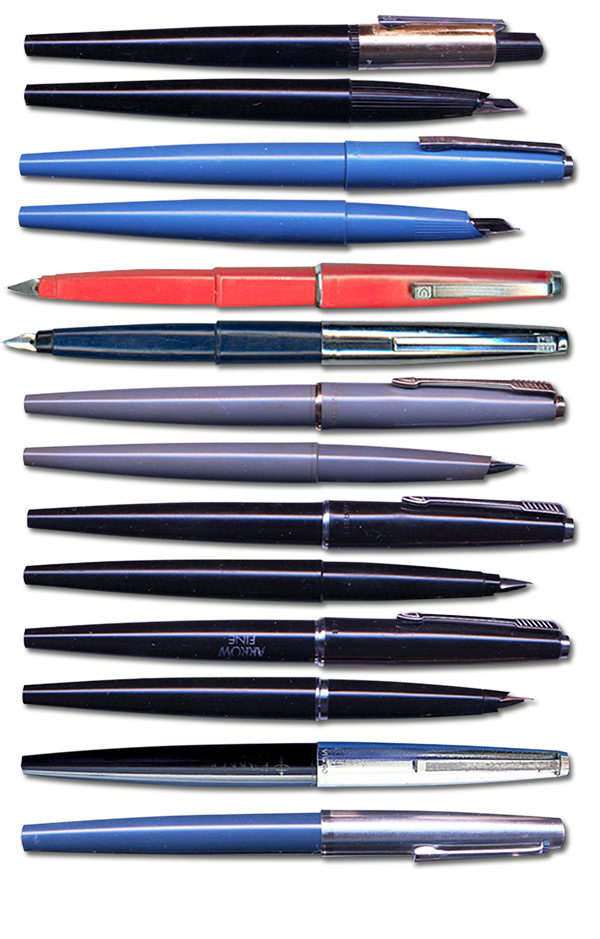
Comparison between several Parker "45" siblings of the early 1960's. On top the Eversharp 10.000 (ca. 1957) on which Don Doman based the design of the "45". Parker used their sub brand Eversharp to try out several features of their cartridge pens. The (blue) Eversharp "Challenger" , introduced in 1962, featured a plastic cap but was otherwise very similar to the 10.000. Next the (red) Eversharp "Big E", introduced in 1961. It sported a plastic cap and a section the same colour as the pen, it was non-removable. Unlike the "Challenger" it had a chrome cap lip. In 1962 the "Big E" was redesigned and the nib/section was now removable. Below the (dark blue) Eversharp Point *7, introduced in 1964. It was very similar to the Parker "45" but had the body design of the "Big E". Below the Parker "19" (gray), introduced by Parker Canada in Toronto in 1961. It's plastic cap predated the "45" Arrow but it had no body clutch ring. The first year "19" had a non removable nib/section, but from 1962 it could be exchanged (see the black "19" pen below). Next a Parker Arrow "45" from around 1962. Below the (black) "Victory", also made in Canada. It had an Eversharp style clip, but sans the "E", and had the removable "45" nib/section. The last pen is a Danish Penol (a Parker subsidiary), also with an Eversharp style clip. The Parker Eversharp production was shut down in 1968.
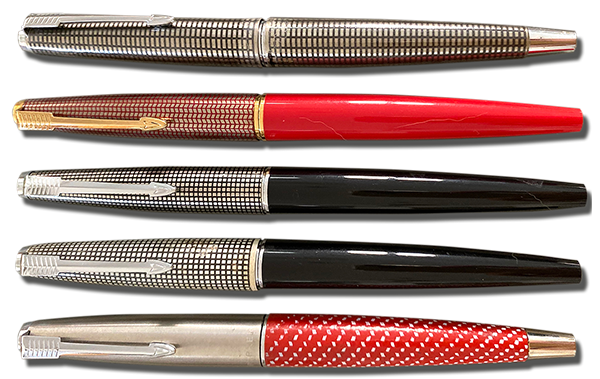
Image © courtesy Tsachi Mitsenmacher
Rare prototype and test market Parker "45" pens.
(Updated 2019)

